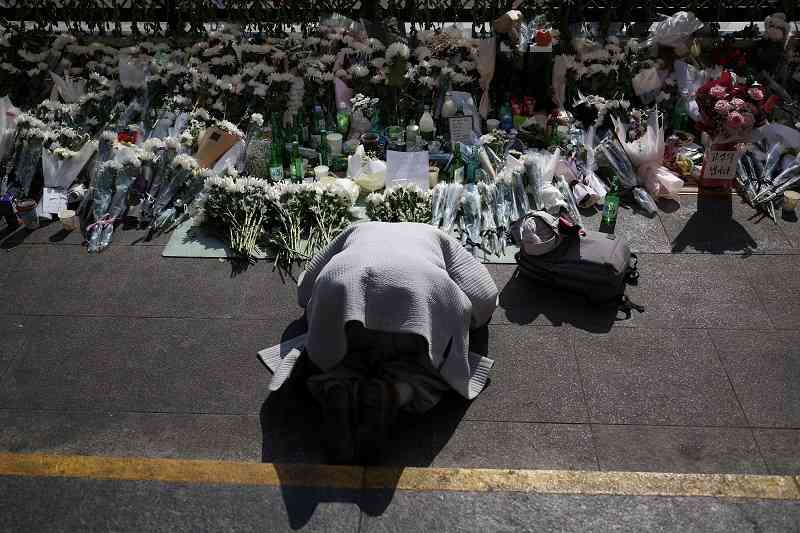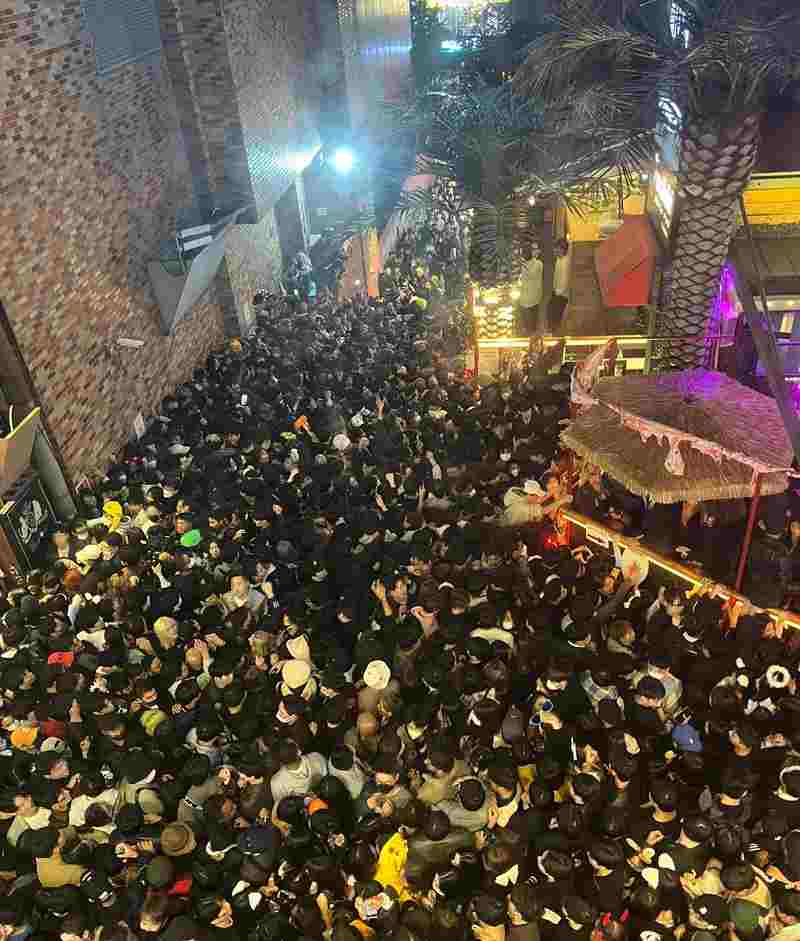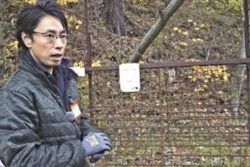
A Buddhist monk makes a deep bow as he pays respects near the scene of a stampede that happened during Halloween festivities, in Seoul, South Korea, October 31, 2022.
13:21 JST, October 31, 2022
SEOUL – At first, the young woman felt herself being squeezed by the packed crowd as it slowly pushed down a narrow alleyway in the South Korean capital, where she had been enjoying Halloween festivities Saturday night.
Then the squeezing became more like crushing, and soon bodies were pressing against her so tightly that her feet were no longer touching the ground. What the 23-year old remembers next is being in a pile of people, her lungs flattened, her legs going numb as she took shallow breaths. She remembers people screaming for help, then falling silent as bodies around her grew limp.
“I thought, ‘Okay, I’m going to be next,’ ” said Juliana Velandia Santaella, a medical student from Mexico who was pulled from the crowd by a man standing nearby. “I really thought I was going to die.”
By Sunday, those frantic moments had given way to a procession of mourners bringing white flowers and candles to the scene, along with questions about how a celebration could have turned into a crowd crush that killed at least 153 people in one of the worst disasters of its kind in recent history.
As condolences rolled in from around the world, South Korean officials said Sunday that they had identified nearly all of the victims, among them 20 foreign nationals from 10 different countries, including two from the United States, one of whom was a 20-year old college student from Marietta, Ga., spending a semester abroad. Others were from Iran, Norway, Uzbekistan and China. The rest were mostly young South Koreans in their 20s and 30s who’d packed into the narrow alleyways of a historic nightlife district known as Itaewon, according to South Korea’s Interior and Safety Ministry.
Among the questions South Koreans are raising in the aftermath of the disaster is why public safety officials did not anticipate the need to manage a crowd of tens of thousands of partygoers expected for the wildly popular Halloween celebrations.
Only two days before, the surrounding Yongsan district unveiled safety measures that included coronavirus prevention, street cleanliness, restaurant safety inspections and crackdowns on potential use of drugs.
Missing from the district’s plans were preparations to manage the anticipated daily crowd of about 100,000 – and the potential for such crowds on narrow streets and alleys to lead to a suffocating crush.
The alley, on a hill, filled up with people Saturday night. It was so packed that when people at the top of the hill fell, it created a cascade. Many people toward the bottom of the hill chanted “stop pushing, stop pushing,” according to witnesses interviewed in South Korean media.
The oversight highlighted limitations in the nation’s policies governing mass gatherings in public places, experts say. Although detailed safety protocols are required for official events, such as festivals, the same disaster prevention methods do not apply to public spaces where large crowds are expected to gather informally, making safety protocols ambiguous with no clear agency in charge, they said.
The exact cause of the crowd surge is under investigation.
Mehdi Moussaïd, a researcher in crowd behavior at the Max Planck Institute for Human Development, said the relatively spontaneous nature of the event – there are no tickets, and no controlled entries and exits – exacerbated the disaster.
He watched publicly available videos of the crush and “saw what I typically see in these kinds of accidents – there were many people, too many people in relation to the available space. [This is] measured by density, so the number of people per square meter.”
In this case, as in others he’s studied, he thinks there were about eight to 10 people per square meter.
“At that level of density, it’s no surprise that the first few people begin to faint, because they’re too tight and they can no longer breathe,” he said. “And if this continues, and that’s what happened, then all the people in that zone will no longer have enough oxygen, even after they faint, and will die one after the other.”
The crush in Seoul was different from those at music festivals or religious pilgrimages, he added, because people are “in a city, and it’s not a planned event with entry tickets that allow for funneling of the crowd. We don’t know which street people will go to.”
The Itaewon alley at the center of Saturday’s crowd crush also appeared dangerous the night before, with crowds swaying side to side in a cramped corridor as their weight shifted onto one another, one partygoer said.
Hayley Johnson, 29, who said she had gone out Friday night to enjoy the atmosphere, recalled crowds being “manageable” until she reached two famous clubs, Fountain and Atelier, which are steps away from the alley where the crush occurred.
When she reached the narrow street, “it was just body to body,” she said. “You would see behind you people were tipping side to side. It really scared my friend and I.”
The event can be described as a crowd crush or surge, but not a stampede, said G. Keith Still, a visiting professor of crowd science at the University of Suffolk in England. A crush or a surge happens when people are packed together in a confined space and there’s movement such as pushing that causes the crowd to fall over. A stampede implies that people had space to run, which was not the case in Itaewon, he said.
The more people who are in the crowd, the greater the force of the crowd crush is. “The whole crowd falls over as one, and if you’re in a confined space, people then can’t get up again,” Still said.
In the immediate aftermath of the disaster, bodies were laid out in the streets as onlookers frantically attempted CPR, pulling shirts over faces to signal when their efforts had failed. Video footage reviewed by The Washington Post shows police officers running toward the scene, a man being treated with a defibrillator, and a woman’s body covered with clothes as blood pooled by her side. Others lay still with mouths open.
“It was almost post-apocalyptic. It was almost all civilians, no medical personnel, trying to save these people,” said tech worker Yoon-sung Park, who helped carry injured people to safer ground for CPR. “People were laid across here all the way down, about a half mile,” he added, gesturing toward Itaewon’s main market street, where emergency responders had wheeled covered corpses into ambulances. “There were so many bodies.”
Looking out from a window in their ninth-floor hotel room Saturday night, Joshua and Angela Smith, siblings from Florida, watched the disaster unfold in the alley below. Joshua saw emergency workers using hand pumps to provide oxygen to three victims being wheeled toward ambulances, and he saw a fourth gurney transporting a body in a bag. Angela Smith heard screams coming from the alley.
“It was horrible, horrible to see,” Joshua said.
Police ushered a 31-year-old doctor from Florida, Sophia Akhiyat, to the alley to help, she said, describing “a pile of humans” at the top of a narrow street that was preventing ambulances from entering the area.
“These people, I think most of them were near death or dead by the time we were helping them,” she said.
South Korean President Yoon Suk-yeol toured the scene Sunday, the alleyways now blocked off with police tape, and strewn with Halloween masks and plastic candy buckets. The nation declared a period of national mourning until Nov. 5, with flags flying half-staff on federal buildings.

A street in Itaewon district is pictured full of people before a stampede during Halloween festivities killed and injured many in Seoul, South Korea, in this image released by Yonhap on October 30, 2022.
"News Services" POPULAR ARTICLE
-

American Playwright Jeremy O. Harris Arrested in Japan on Alleged Drug Smuggling
-

Japan’s Nikkei Stock Average as JGB Yields, Yen Rise on Rate-Hike Bets
-

Japan’s Nikkei Stock Average Licks Wounds after Selloff Sparked by BOJ Hike Bets (UPDATE 1)
-

Japan’s Nikkei Stock Average Buoyed by Stable Yen; SoftBank’s Slide Caps Gains (UPDATE 1)
-

Japanese Bond Yields Zoom, Stocks Slide as Rate Hike Looms
JN ACCESS RANKING
-

Keidanren Chairman Yoshinobu Tsutsui Visits Kashiwazaki-Kariwa Nuclear Power Plant; Inspects New Emergency Safety System
-

Tokyo Economic Security Forum to Hold Inaugural Meeting Amid Tense Global Environment
-

Imports of Rare Earths from China Facing Delays, May Be Caused by Deterioration of Japan-China Relations
-

University of Tokyo Professor Discusses Japanese Economic Security in Interview Ahead of Forum
-

Japan Pulls out of Vietnam Nuclear Project, Complicating Hanoi’s Power Plans




















